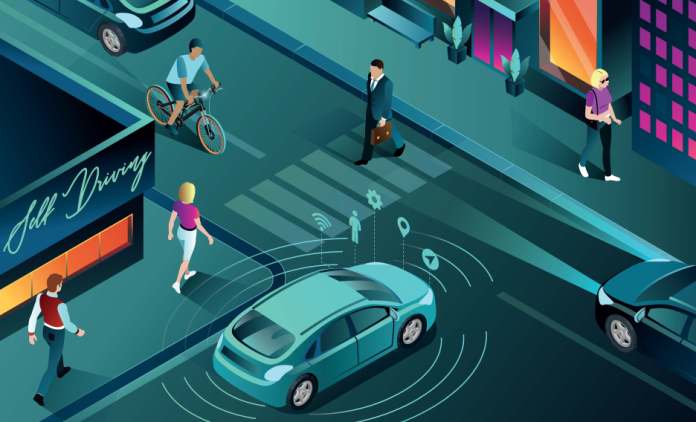
(Source: Shutterstock)
There is no doubt that making vehicles safer and smarter is at the forefront of autonomous vehicle (AV) design. This requires a mix of sensing technologies, security schemes, and processors.
Despite the improvements in automotive safety systems, there is more work that needs to be done to better protect all road users. Some of those designs address systems that warn drivers of unseen hazards ahead with a “look around the corner.” Most recently, a partnership between Cepton, Inc., ALP.Lab GmbH, and TE Connectivity completed a proof-of-concept project, called Periscope, that extended a driver’s field of view by using LiDAR sensors.
This system was able to look around the corner and warn the driver about five seconds before the pedestrian became visible to the driver. The design combined Cepton’s intelligent 3D LiDAR perception; ALP.Lab’s expertise in system integration, testing, and data analytics; and TE’s vehicle-to-everything (V2X) solution.
In this month’s issue, we provide an update on the latest advances in AV design, including improvements in LiDAR and radar sensors as well as secure processors. We also look at the design challenges in delivering fail-safe and secure control of AVs.
The latest advances in LiDAR and radar sensors, in combination with cameras, will enable the highest levels of autonomous driving, reported Stefano Lovati, contributing editor. A recent trend in both LiDAR and automotive radar sensors is the addition of the fourth dimension, which provides detailed information on both 3D position and velocity of objects located in the vehicle’s surrounding area, he said.
In most cases, automotive cameras and radar are sufficient to cover current requirements; however, the highest levels of autonomous driving will require LiDAR sensors, said Lovati. Starting from Level 3 autonomous driving, most carmakers agree on the need to use LiDAR sensors, and for AVs, LiDAR sensors are key parts of their safety systems, including blind-spot monitoring, lane-keeping assistance, lane-departure warning, and collision warning.
Lovati reports that radar sensors are successful in identifying objects very close to the vehicle, and they can determine how far away these objects are and at what speed they are moving, which is why automakers use radars for ADASes like parking sensors, blind-spot monitors, and adaptive cruise control. Data fusion also plays a role with the integration of visual sensors (cameras), radar, and LiDAR to obtain more detailed information about a vehicle’s surroundings when in motion.
Automotive sensors, such as radar and LiDAR, are key to improving road traffic safety and reaching high levels of autonomous driving, said Marta Martínez-Vázquez, senior staff product marketing engineer for the Automotive Analog Product Marketing Division at Renesas Electronics Europe GmbH, and their use will help reduce the number of traffic accidents and deaths on the roads worldwide.
However, the way the radar data will be handled will depend on the vehicles’ architecture, she said. The higher performance of the central computing units is also driving the in-vehicle E/E architecture to shift to a distributed architecture, she said.
“In addition, the number of domain controllers will increase, while zone controllers will also be introduced before a fully centralized E/E architecture is established, in which the vehicle’s central computer will be connected to the sensors through the zone control units,” she added.
At the same time that vehicle architectures are undergoing transformations due to the introduction of advanced features for improving safety, performance, and driving comfort, the number of on-board electronic devices, controlled by dedicated electronic control units, has escalated, reported Lovati. At the center of these systems are automotive processors with functional safety and security features, dozens of sensors, and artificial-intelligence algorithms.
“The evolution of the E/E architecture has inevitably entailed the need to address and manage the security of vehicles, which are increasingly exposed to potential attacks by hackers or criminals,” he said. “With security being paramount, automotive processors must have built-in functional safety and security features for protection from malicious attacks.”
In addition to design challenges around new vehicle architectures, automotive OEMs face challenges in the development and integration of intelligent transportation systems and infrastructure. Per Vices gives us an overview of the current ITS industry and discusses how software-defined radio (SDR) devices can be used in the development and integration of ITS infrastructure.
This includes fail-safe command and control of AVs, which require high-speed and low-latency data links for time-critical decision-making in the self-driving processes and how SDRs play a role in robust security schemes and encryption algorithms to provide immunity against malicious attacks and RF interference.
Also in this issue, automotive LED lighting is making big adoption inroads, especially in electric vehicles. Demand continues to grow thanks to its better illumination, higher levels of integration, and the need to cut CO2 emissions.
Don’t miss the roundup of new products launched at electronica. Products range from power ICs and sensors to wireless modules and frequency control and timing devices.
Advertisement





